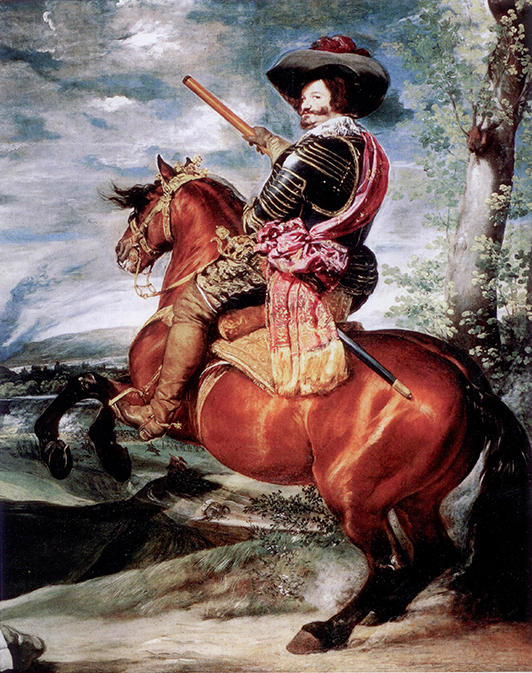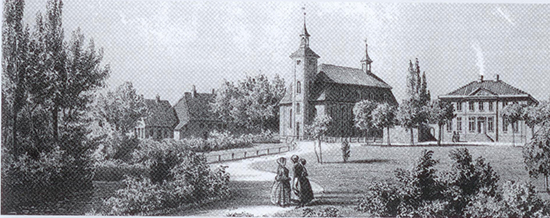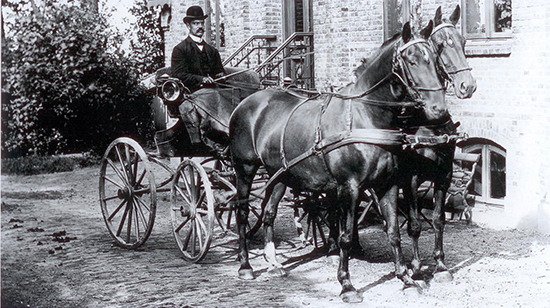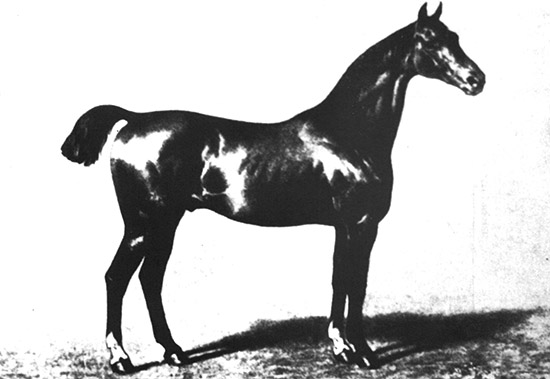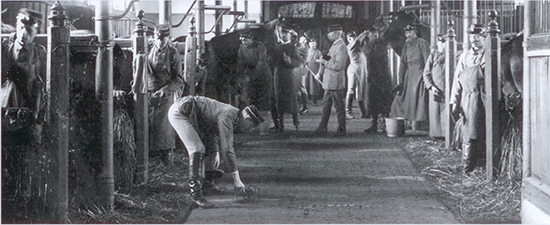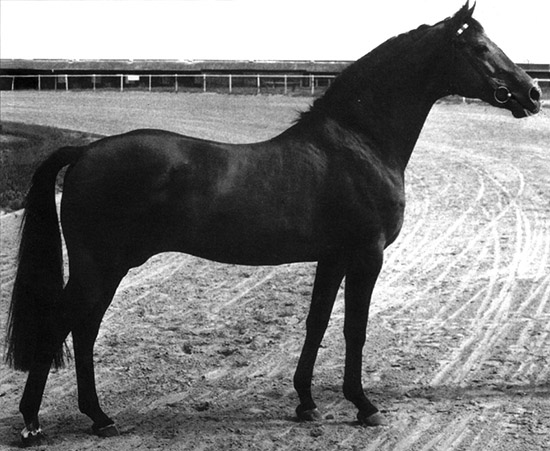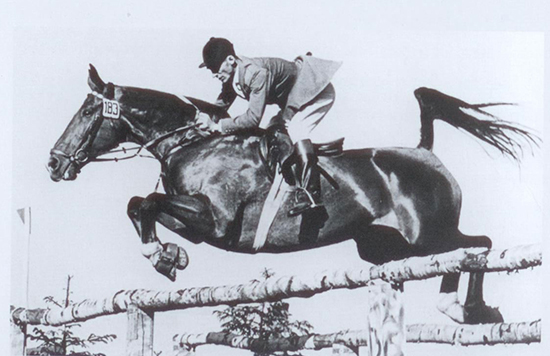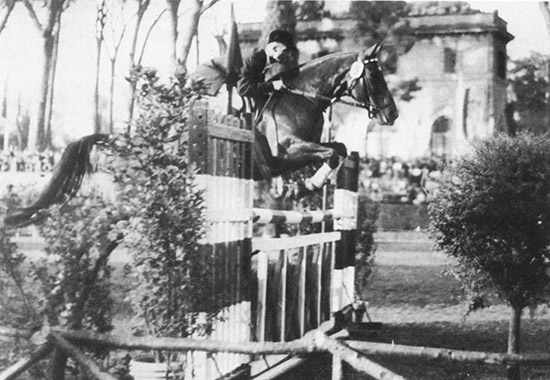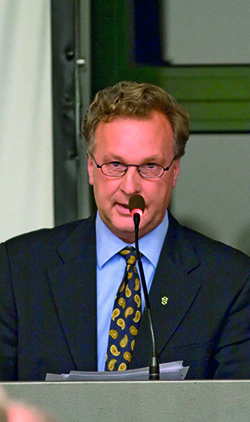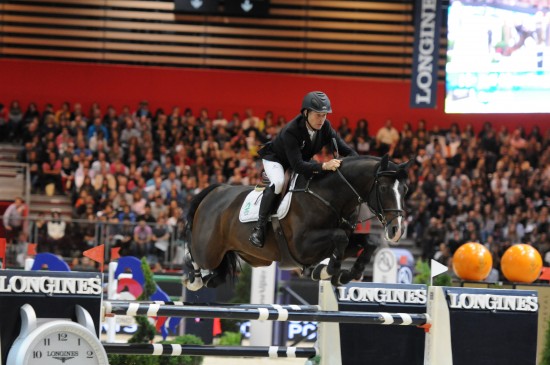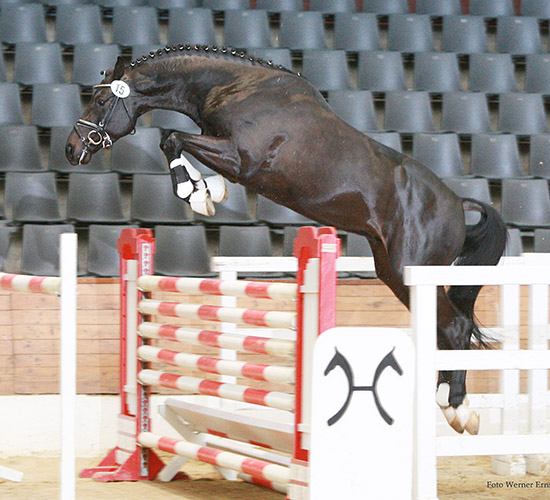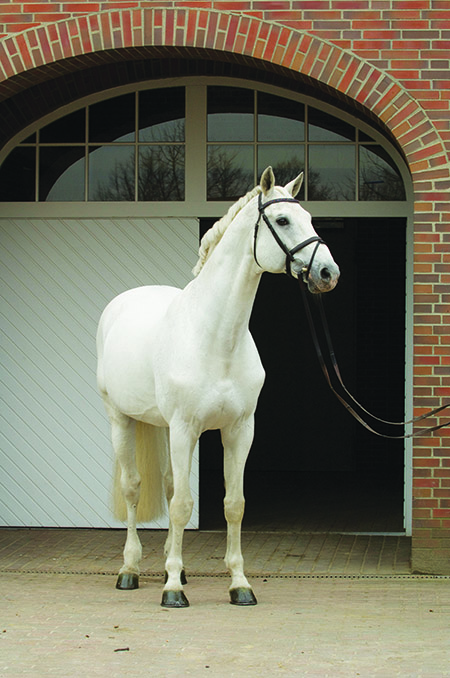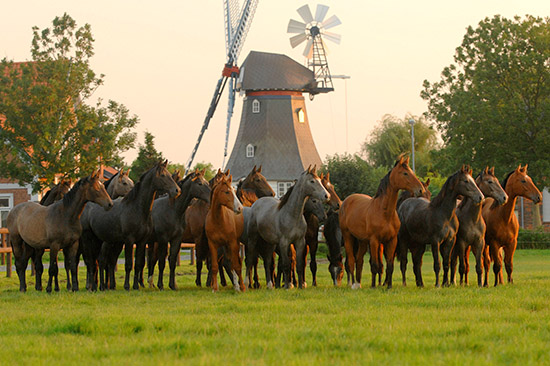
The nineteenth century British Prime Minister, Lord Palmerston once said that historians went mad, or to an early grave, trying to understand Schleswig-Holstein’s history, so we’ll skip the north /south divide and the 400 years of Danish rule, and cut to the chase. Very early on, the horses of Holstein, thanks largely to the monks who bred them with care, became famous all over Europe.
Phillip IV riding a bay horse – one of the Holstein stallions imported to the Spanish court – the painter? Velazquez
King Philip II of Spain is said to have used nothing but Holsteiners in his stud at Cordoba, and certainly the horse in the famous painting of the King looks very like a Holsteiner.
Uetersen Monastry where Holstein’s horse breeding tradition began 750 years ago
The French King Louis XIV was another enthusiastic customer – even the basis of the Hanoverian stallions at Celle came from Holstein. And the local authorities were quick to maintain quality standards. As early as 1719, awards were given to fine stallions owned by the farmers – but the stallions had to be between the ages of 4 and 15, at least 157.5 cm (15.2) without shoes, and have sired at least 15 foals in the previous year. Annual inspections were made and some stallions branded and permitted to breed (but not be sold) while other stallions were barred from breeding.
Georg Ahsbahs and his carriage team
In the nineteenth century, the Holstein horse-breeding scene was greatly shaped by three outstanding horsemen: The Duke of Augustenburg, the economic advisor, Georg Ahsbahs and Claus Hell Sr (yes, a distant relation of the famous Maas J. Hell who shaped the modern Holsteiner). The Duke, in particular, was responsible for importing very fine Thoroughbred stallions, and encouraging the local breeders to use them. One of these stallions, Protocol (born in 1828) was to found the Ethelbert line that continues into the present day through the dam line of his illustrious descendent, Lord. In the first half of the 1950’s, 60% of the Holsteiner state stallions belonged to this line. Ethelbert was by a Thoroughbred stallion, St Fagans, out of a mare of Yorkshire Coach Horse breeding.
Ethelbert, the dominant line…
Ahsbahs and Hell were organizers as well as horsemen, forming studbooks to regulate breeding. The breeding goal of the association formed by Hell was set out in 1885: “A refined, powerful carriage horse with strong bone structure and high, ground covering strides, which at the same time should possess all the qualities of a heavy riding horse.”
Ahsbahs created the Holsteiner Stud book, and crowned his activities by helping found the Elmshorn Riding and Driving School in 1894 – this was the first such institution in the world.
The scene at the Elmshorn Riding and Driving School
Holsteiner horses dominate at the Berlin Horse Show in 1894
In 1926/7 the Federation of Horse Breeders of the Holsteiner Marshes were forced to turn over all their stallions to the State Stud… but with the onset of mechanization, the farmers abandoned their horses and by 1960, the government dissolved the State Stud. The Holstein breeders federation took over 30 Holsteiner stallions, and three Thoroughbreds. The time had come to transform the Holstein horse from an agricultural worker to an international competitor.
In 1961, there were 54 Holsteiner stallions at 39 stations, made up of 29 pure Holsteners, nine from the Achill line and 20 from the Ethelbert line, seven Thoroughbreds, six Thoroughbred sons, twelve stallions of other breeds (Hanoverian, East Prussian, Anglo-Arabian or Arabian). The registered mare band had shrunk to 1,322 – eleven years earlier, in 1950, it had been just under 10,000.
According to the authors of The Holsteiner Horse:
“It wasn’t possible to talk about a healthy streamlining process; it was a catastrophe, the Holsteiner horse seemed to be heading for doom. The Association was more or less managing a bankrupt estate, which was shrinking all the time. But that wasn’t the only problem. The motorisation in the agricultural sector, had left its mark on the appearance of the Holsteiner. (Today one talks about the ‘second elephant period’, the first having occurred after the First World War due to similar considerations). In many countries, Germany included, the equestrian sport in general and the competition sport in particular, experienced a rapid development which nobody had dared to dream of in 1945.”
Internally a battle for the future of the breed was underway:
“The Traventhal State Stud had a hindering effect of the process of change within the breed. They preferred working horse types with the same format as Fangball and Marder, who excelled more as a result of their substance than through their riding horse traits. Sport stallions form the pre-War years fell by the wayside. A group of younger breeders, who recognized the future of horse breeding lay in sport, and that this reqjuird a re-orientation of the breeding goal, had difficulty asserting themselves against the conservative breeders. One of the spokesmen, the breeder and horse dealer, Rheder Thormählen, form Langenhals, who bred mares that were sport tested, was described at the time as an ‘adventurer’.”
However finally it was recognized that the future for the breed was in sport.
According to Romedio Graf von Thun-Hohenstein in his book, The Holsteiner Horse: “Instead of simply giving up and allowing the breed to wither away as a victim of economic development, the dynamic Board of Directors decided to totally reshape the horse which had been entrusted to them. The work clothes and habits of the hard working rural labourer were to be traded in for the custom tailored suits and elegant manners of the international athlete. This all had to be accomplished without relinquishing indispensable physical and mental strength and natural talent of the robust country boy.”
And that transformation involved – as it had in the nineteenth century – a massive influx of Thoroughbred blood.
Again The Holsteiner Horse expresses it well:
“Time was pressing. The market was demanding the sport horse; if one didn’t want to lose market share, one had to act quickly. Under these circumstances the breeding managers thought it was pointless to wait for decades for the right Thoroughbred and only use one or two stallions. So they followed the motto, don’t do anything in half measures, under the conviction that the chance of finding two good stud stallions among 25 Thoroughbreds was higher than if they only tried out a handful. The task at hand was then to find Thoroughbreds that resembled as closely as possible the ideal of the riding horse that they wanted to breed, regarding their exterior, type, quality of the paces and inner qualities.”
Ladykiller, one of the Thoroughbred stallions that saved the Holsteiner horse…
One of the prime movers behind this transformation was Hellmuth Horstmann, who in 1952, was appointed Managing Director of the Holstein Association. A former cavalry officer, he was responsible for maintaining the studbook, as well as taking care of, and marketing, the stallions. He and his deputy, Jasper Nissen set off to England and Ireland looking for suitable stallions. One he found was Cottage Son xx, followed by Marlon xx and Ladykiller xx who was purchased in Germany.
Breeders’ attitudes had changed too. “Unlike half a century laster, the Throughbreds were well accepted by the breeders at that point of time. The market value for half-bred foals, who received different coloured foal certificates, namely light blue instead of red, was higher than that for the pure-bred Holsteiner foals.” (The Holsteiner Horse)
By 1976, of the top 62 Holsteiner stallions, 7 (12%) were Thoroughbreds, 24 (30%) were sons of Thoroughbreds, and there were three grandsons of Thoroughbreds – well over half the stallion band. Of the rest, there were three Selle Français (although two of those Selle Français, Cor de la Bryère and Silbersee were both by Thoroughbred stallions), seven sons of Selle Français (four of them by ‘Corde’), a handful of descendents of the Anglo Arab, Ramzes and just six sons of purebred Holsteiners – that’s 10% of the total! These ‘A’ stallions covered 2874 mares – the breed had been saved.
Fritz Thiedemann and Meteor put the Holsteiner on the map…
In 1949, Horstmann was also responsible for appointing the gifted horseman, Fritz Thiedemann to the Elmshorn Riding & Driving School, and from this base Thiedemann spread the fame of the Holstein horse around the world. Thiedemann won two gold and two bronze medals at the Olympics, and is still the only rider to have won dressage and jumping at the same Olympics. In 1952, he won a team bronze with Chronist xx in the dressage and an individual bronze in the jumping with Meteor. He won the German Jumping Derby on five occasions, each time with a different horse: 1950 – Loretto, 1951 with Meteor, 1954 – Diamant, 1958 with Finale, and in 1959 with Retina. In 1958 he won the European Jumping Championship with Meteor, his most famous partner.
Meteor was born in 1943, in Nindorf, a small farming village, in the stable of Otto Dreeßen. Meteor wasn’t his first name since on that farm all the fillies were called either Lotte or Liese, and all the colts, Hans or Mortiz.
Moritz, as he was then known, was driven in a single harness as a three year old, and was given the job of taking the milk from the farm to the local dairy.
At the time, the enthusiasm for equestrian sport was spreading to the farmers’ sons, and Moritz started competing at the end of 1948. In 1950, he won the puissance over a height of 1.80 m at Meldorf, under the watchful eye of Thiedemann, who noted his ‘sluggish canter, the lack of impulsion, as well as the head and the eye, everything being rather sleepy and powerless.’ Nonetheless Thiedemann thought he was suitable for advanced level jumping – but Moritz had already moved on, into the ownership of Willy Brandt whose daughters, Marlen and Elke, were very successful in equestrian competition. Now called Meteor, he won the advanced class in Berlin with Elke Brandt.
Willy Brandt was a friend of Thiedemann’s, and offered him the ride on the seven-year-old in the 1950 German Jumping Derby, as his daughters were too young to compete.
It was not one of Thiedemann’s more successful rides, with 28 faults. In his book, ‘My horses – My life’, he remembers the day: “While in the ring I thought it was the worst ride in my career, but afterwards I saw things quite differently. In spite of the faults and the disharmony between the obstacles, a few of the jumps told me that Meteor was going to be a significant horse for the future.”
Fritz Thiedemann was right. Two years later, they won individual bronze at the 1952 Games, followed by team gold in Stockholm and Rome.
In the end, the pair achieved over 150 victories and 501 placings and Meteor was hailed as the most successful jumping horse of his era… and the famed of the Holsteiner jumper spread throughout the world.
The trend was given new impetus by Maas J. Hell when he took over the management of the Association in 1972. He was one of the first to see that stallions would have to make a name for themselves in competition, and he set about matching the Holsteiner Association stallions with successful riders.
Constant, by Cor de la Bryère, and Ronald, by Ramiro, were ridden by Hans-Günter Winkler, the French import, Silbersee (Silver Matal xx) and Caletto I (Cor de la Bryère) went to Michael Rüping and Calando I (Cor de la Bryère) to Karsten Huck.
The policy was carried on by Norbert Boley when he was appointed in 1981. Corrado I (Cor de la Bryère) and Cassini I (Capitol) were campaigned with success by Franke Sloothaak, Caretino I (Caletto II) and Ludger Beerbaum, Carthago (Capitol) and Jos Lanskink, Cascadeur (Caletto II) and Cassini I (Capitol) and Bo Kristoffersen, all carried the Holsteiner flag in international competition. Today, we see Casall starring with Rolf-Goran Bengtsson.
Right from the start the Association was involved in marketing horses out of Elmshorn. Between 1895 and 1901, a total of 1,358 horses were sold.
Driving horses were particularly in demand. A team was sent to the United States to compete at the World Exhibition of 1898. In the 1930’s the trend was more to jumpers like Nordland, who was a member of the gold medal winning jumping team at the Berlin Games in 1936 with Marten von Barnekow and who won the German Jumping Derby of 1938.
Original Holsatia – exported to Mexico
After the Second World War, horses sold out of Elmshorn included Original Holsatia, started by Fritz Thiedermann before export to Mexico. Baden who was a member of the German Olympic team in Helsinki in 1952 with Hans Hermann Evers, and the dressage horses, Antoinette (Anblick xx) with Josef Neckermann, and Granat (Consul) with Christine Stückelberger – both of them gold medalists.
The Elmshorn sales yard usually has about 40 horses for sale, ranging from youngsters starting out to successful competition horses. Recent success stories include Think Twice (Corrado) and Leopold van Asten, Catwalk (Caretino) and Christian Ahlmann, Lugana (Lord) and Stefan Lauber, and Magic Bengtsson (Landos) with Peder Fredericsson and Björn Nagel.
In the 1970’s, Maas J. Hell established the autumn riding horse auction in the Holstenhall in Neumünster. This was combined with the stallion licensing and an evening show program. After a slow start, the auctions took off, and between 1976 and 1979, the auctions achieved the highest average price of all the German auctions. Many top horses have gone through the auction, including three time German Jumping Derby winner, Collin (Contender) ridden by Toni Hassman, Controe (Contender) who went to Marco Kutscher, and Cristallo (Caretino), a star in the USA with Richard Spooner.
And to protect their position as the world’s prime producer of jumping horses, the Holsteiners have adopted exactly the opposite strategy from that of their near neighbours in Hanover. They do not encourage the sale of their frozen semen, and far from establishing ‘daughter’ organizations around the world, the Holsteiner Verband only consents very much under sufferance and because they are legally required to do so, to service breeders in parts of Germany outside the traditional breeding area.
Norbert Boley, responsible for the stallions and the marketing of the Holstein Verband, in an interview in 2007, agreed with me that Holstein is still basically a geographically based entity:
“Yes. Our idea is that we first have to do a good job for our breeders in our area but in the last few years, we get more and more members in other breeding areas of Germany, and elsewhere in Europe, especially Belgium and The Netherlands. Also in Denmark – but that is historic, there has always been a good connection with Denmark. It is now a question of the law in Germany, now we have to work with people who want to breed Holsteiners in other parts of the European Union, so we have to open our system – but our main interest is to have a good breeding system for our breeders in our district here.”
You have a relationship with the American Holsteiner breeders?
“That is also a bit of an historic thing. Thirty five years ago there was one person in the United States, he had an arrangement with our Verband at the time, but we had problems with that whole system, and came to an arrangement with the association in the USA – we are connected but they have their own system to select the horses and to breed the horses. Our breeding area is very different from the USA, it doesn’t make sense to try and use our system there. In the USA, the distances are so big, it’s the same as we learnt in another big country – Australia – it’s not possible to have one place where the mares and foals are selected because the people have to come from so far away. Here it is very simple, there are ten places in our area, and there are always 60 to 100 three-year-old mares at one place. But it is not possible to do that in the United States, for example.”
It’s the same in Australia?
“They are doing their own business. They are working in the same system to select the mares and stallions, but it is not controlled by us, and they have their own life. They get some support from us but they have to create their own system in their own country – they have to find what will work. We cannot transport our system to other countries and say you have to do it exactly the way we are doing it here.”
The changes in EU regulation mean that there is some opening on the Holsteiner book, but it is a grudging concession rather than a looked for expansion:
“We have to follow the rules and work with breeders in the other areas, that’s for us a big change because in history we have always said that this is our breeding area, and we are working in this area, and we have a permit from the government to operate in Schleswig-Holstein and not more. At the moment if you have a mare and you want her selected for our studbook, then you have to come here to our country. It’s the only way to get mares into our book. Also we accept only our bloodlines – we don’t accept Hanoverian mares, or Westfalien, or Oldenburg mares. They have to have our bloodlines otherwise they have no chance to get into our studbook. That is very different from the others – and for sure, our idea is to continue this way because we are not interested in having a big number of members or a big number of mares. We would like to breed in our system with our lines and not with different breeding lines.”
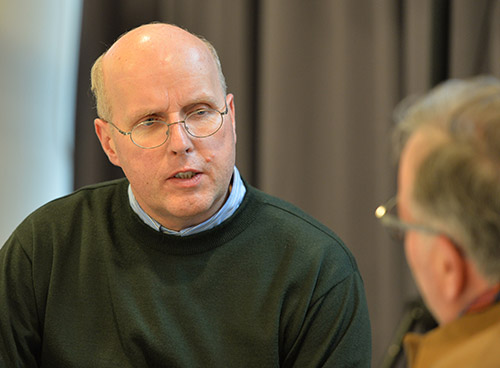
Update with Dr Thomas Nissen… (an interview conducted in February 2014)
Dr Thomas Nissen became the breeding director of the Holsteiner Association in 1989. He joined the Holsteiner Association in 1988 after completing his Agriculture degree at Kiel – the appointment was a logical next step since his thesis topic was The mare performance test and fertility of the Holsteiner horse.
One of Dr Nissen’s primary concerns has been the modernization of the Holsteiner horse using English Thoroughbreds, and he has brought into the breeding program stallions like Königspark xx, Grundyman xx, Sir Shostakovich xx, Barnaul xx, Mytens xx, Parco xx, Esteban xx and Heraldik xx. He also opened the doors to foreign blood, primarily using French stallions, with Quidam de Revel now a major influence in Holstein. Famous sport horses such as Donnerhall and much later, For Pleasure and Stakkato were approved in breeding trials under his leadership. I caught up with him at Neumünster show, in the heart of Holstein, and recorded with far ranging and frank interview.
Talking to breeders and breeding officials all over Europe, breeding is way down on previous years, is this downturn affecting the Holsteiner Association?
“Yes. In Holstein, we have had a very good market and the breeders could sell foals for good prices, until three or four years ago, when things started to change, and the numbers started to go down every years, about 10-15%. I think it is now down about 40% in the last three or four years.”
Is this the effect of the global financial crisis?
“I think the financial crisis was one factor, but we should be aware that there is a big change in social development, we have to recognize this. In Europe, the society has changed, the birth rate goes down and the young people have many sport alternatives, and riding and the whole horse industry, has been affected by this. The time we have had, will not come back. A new century has begun, and we as breeding associations, and also our breeders, have to accept this, and make new breeding programs to fit this new situation.”
Will there be a great reduction in mare numbers – like there was at the end of World War II?
“I think in every crisis, you also have big chances to find a higher level in the quality, and that is our aim, that we say to our breeders, okay, the situation is as it is, and the chance to take a profit out of this is to become better and better in the quality. We have a high level of quality in jumping in our breeding population, but when I started 20 years ago, we had 4000 brood mares, then it grew and grew, very quickly, especially from 6000 to 9000, and I think this period was too short to maintain the good quality. They produced many horses but not with enough quality, and now it goes on, and we have around 7000 brood mares and that is a good basis, maybe six or six and a half, is also good. A lot of breeders still own their brood mares, but they will not cover them. So we have 7000 broodmares but we will have around 3000 foals each year. We can only produce as many foals as the breeders can sell, but we say to our breeders, in this situation it is necessary that you hold on to your quality mare, and now it is time to bring your quality mare to a good stallion because in four years, quality riding horses will become more expensive because the numbers have gone down.”
“In Holland, Scandinavia, France, all the breeding regions, the covering rate is down 50% so in a few years we will have a small number of quality performance horses.”
The strength of Holstein in the past has always been sticking to breeding jumping horses – will that be the strength in the future?
“In the last ten, fifteen years, the other breeds have bought good genetics from the Holsteiner and a lot of very good stallions have gone to those areas, so the jumping quality grows and grows in those places – that is a problem for us. But I think it is the same situation if you have a factory for cars, if you produce a good car, like a Porsche or a Mercedes, an Audi, you have a marque, a brand image, and I hope that the marque of the Holsteiner is very popular all over the world and all breeders, who want to breed jumping horses will come back and take the original Holsteiner again. It is necessary that we have very good breeding programs to produce more interesting horses with a better quality than anyone can find elsewhere. You can drive a Japanese car if you want, but for the people who want to express their personality, there is an identification with the branding of certain top cars, and I hope that the riders and the trainers will continue to regard the Holsteiner as the best.”
For twenty, thirty years, the Holsteiner mix has been a variation on two chords: Cor de la Brère and Capitol with the occasional Thoroughbred, will this continue to be the recipe for the future?
“The Holsteiner population is a clear population, because we have unique mare lines – we will not take any mare lines from the French or the Dutch, Hanoverian, Westfalia, whatever. We only take Holsteiner mares in our breeding books, and all the mares in our books have a Stamm number. The older mare lines have numbers and you can follow those numbers through and learn something about the quality of the Holsteiner breed. We will not change that.”
“It is only some stallions that we take from outside. Thoroughbred stallions, we need the Thoroughbred to make the horses intelligent, tough and modern. We are always looking for foreign blood, and we prefer stallions from France and we are looking for them, but it is difficult because every breed, the Dutch, the Belgian, all the German breeds, they go around the world looking for interesting blood, and with the globalization and the flow of information on the internet, it is very hard to find an exclusive source of new blood anywhere. We need to add fresh influences to our population with stallions from outside.”
Were you surprised with the success of Baloubet? I remember one of your famous breeders, Mr Thormähen, saying to me, I used Baloubet, but I hated the foals… Now maybe he thinks differently!
“We took Baloubet years ago in our breeding program. It is not easy, he is a little bit of a strong, heavy type with not so good a face, and he needs special mares. There is no discussion, he is one of the best, if not the best, producer of jumping horses in the world. We look for this blood, our Association has a son, Baracuda, out of a Contender mare. He is a lovely type, he has a good face, not too heavy, he is a good jumper and we try it with him. We have approved grand sons, like Balou’s Bellini, by Paul Schockemöhle’s stallion, Balou du Rouet. It is a very nice stallion, he is out of a Holsteiner mare by Lord Incipit.”
“I hope we will get some benefit from these stallions, but you cannot just hope that Baloubet du Rouet will bring success in the Holsteiner population, he can play a small part.”
How important do you think it is that a stallion should be a good competitor himself? Baloubet was a fabulous competitor, but Balou was pretty ‘normal’, is that a big factor for you when you look at a stallion?
“I think there is also a danger in that we live in this era of globalization, we live in a total information society, and the danger is that only a handful of breeders can handle this information. A lot of them look and say, oh how nice, he is in competition, that is the stallion for my mare, they look on the internet for the dealer and buy the semen on the internet. They never look at the stallion live, and say, okay, is he the right stallion for my mare or not? I think that is necessary. If you go back 30 years or so, there was no artificial insemination, and the breeders had to go to the stallion station to look at the stallion, okay this stallion is right for my mare – and I think we bred better horses than today. Today everyone says the best stallions are in competition, Baloubet, Quick Star, Kannan…”
Casall…
“Casall is a slightly different situation, I will come back to him, but sometimes the stallions are only good competition horses and not good in breeding. We know this because we had the stallion, Silbersee, he was the perfect sport horse, lovely type, Michael Rüping won the Hamburg Derby and many Grand Prix with him, but he was no stallion. His offspring were very different types, different performance, and today we have no influence from him. But the breeders only see the competition success on the TV and they think that is the right stallion, and when he is popular, they hope, oh if I have a foal from this stallion, it must be interesting to the buyers. But I think only the quality of the horse will bring success, not the pedigree. That is a problem today, there are a lot of stallions that are only popular stallions but not the best breeding stallions…”
Is this partly because there is so much mis-information on the internet. I get emails, progeny of my stallion have won so many Grand Prix in the past 12 months, but when I go to the database, this is not true, total lies, but once it is on the internet it gets repeated, so it must be true…
“No body controls this information, and that is one of the biggest problems, so there is a lot of misleading information, lots of good marketing, it is a chance for the stallion owners to market their stallions, but the breeders will not have success with all these nice pictures and clever marketing…”
“I will come back to Casall because Casall is in my eyes, for the Holsteiner population, a special stallion because he is a successful horse in competition but he also does a fantastic job as a breeding stallion. He is himself not the perfect type you might dream about. He is a lovely horse but his genes and his mother line is one of the best in the Holsteiner population. There are lots of good competition horses and stallions on that mother line. It is not so big a mother line, it is a small line but always with very good quality in the horses.”
“Casall is by Caretino, who was a Caletto II son – one of very few because Caletto II only bred for a few years before he died, but he made a very good job, and of the few stallions, Caretino was the best of Caletto II. Casall has a Lavall mother, and Lavall is Landgraf and Sacramento Song. So we have the influence of the Thoroughbred by Sacramento Song, and Landgraf’s sire, Ladykiller, and Caretino by Caletto II by Cor de la Bryère, by the Thoroughbred, Rantzau. In the background a lot of Thoroughbred, combined with a good mother line and good performance stallions. Landgraf, and Sacramento Song, who not only brought Thoroughbred influence, but also good jumping quality. Behind this is the Ramzes’ son, Raimond, and influence of Ramzes was enormous in the Holsteiner population, especially for performance horses – Capitol is one of the stallions with the greatest influences of Ramzes blood in his pedigree. This combination produces the high genetic level of Casall.”
What particular mares does Casall need?
“You have to look a little bit that they are long in their legs, this is the type Caretino needs and also Casall needs. They should not be too heavy, and then he will do a good job on different backgrounds of pedigree and blood. Always the combination is good in Holstein if you find in the background the blood of Cor de la Bryère or Ladykiller. Casall should find a lot of mares with this in their pedigrees in Holstein.”
Diarado – a star at the licensing…
Looking at the new stars, I know that Diarado was the number one stallion on the German FN breeding values, but looking at the two colts that were not approved at the KWPN licensing, they looked a little pretty but without scope – and Diarado has yet to appear on the international circuit, while Casall had already won a Grand Prix when he was nine years old…
“I think with Diarado it is another situation. Casall when he was young and came to our approval, he was a little small, not so perfect like Diarado, and the breeder thought that he had a nice pedigree, so we try him – but not like Diarado, Diarado was a champion when he came to the approval. The whole jumping world applauded Diarado, he was one of the best stallions we have had at the approvals in Holstein, he was such a perfect type, and he was a very good jumper, the spectators gave him a standing ovation. He had an enormous background when he started his breeding career, and that was not so easy for the owner, for the rider, and a lot of breeders wanted to use his semen, he had hundreds of mares and it was hard to manage the covering and the sport career. They tried, and I think he was quite good as a young horse. We had him in Holstein a few weeks ago in a stallion presentation, and he did it very well, he is a good jumping horse. If he has that last capacity for jump a Grand Prix, we have to wait and see. I don’t know if the training of the rider goes in this direction, in the last few years, the breeding has been the main point not the sport career – maybe they change it now and work with frozen semen. He makes a very good job as a breeding stallion, we have a lot of good offspring, we approved some sons – we have a very interesting four year old son, Dinken out of a Caretino / Cassini mare, he is a perfect jumper with a lot of capacity, and we have a lot of good daughters in the performance test of the young mares.”
“I can understand why Diarado has such a high breeding value, based on the mare tests, and the 70 day test of the stallion, and there are a few offspring in competition. I think in the years to come we will see his offspring competing at the higher levels.”
But it is true that some of the greatest jumping stallions of all time have been rejected when they came to their licensing and only licensed when they succeeded in the sport…
The great Corrado…
“Corrado was one… but that is one of our aims of our Association, to bring stallions in the top level in the sport, now Casall, we also have Quintero (Quantum / Chaimonix) who is with Rolf-Goran Bengstsson. He also has several younger stallions in his stable who he is trying, and we hope there is one or two that can come into the highest level of the sport, but it is very expensive to bring stallions to this level, and it is a long and a hard way for an Association because of the money involved. We have to find sponsors, like Mr Romo at La Silla, or now the Danish stud farm, Stutteri Ask with Casall. Not every stallion is able to go to this level, it is not just the question of capacity, there are many factors that must come together for a stallion to reach this top level, a big influence is the rider, you need a top rider to reach this level. It is not a problem of the genetics, there are many other factors that must come together.”
We have seen a number of very important influences in Holstein, the Thoroughbreds, the influence of Cor de la Bryère, what would you add to the mix now if you could?
“I think we are working now always with a high level of quality in terms of type, it is difficult to always make the type better and better. We have a breeding aim, it is on the paper, but it is also always in our heads, we always look for the perfect horse – but you will never find the completely perfect horse. You always have to weigh up the different points. I would say with Diarado, he was the perfect type – he was a type that we aim to find. What is interesting is that he is also out of a very good mother line, one of the best. His mother is by Corrado, who was a perfect international jumper, and then the combination with Diamant de Sémilly. Diamant de Sémilly is not known as an easy stallion because he is a very heavy type and produces offspring with a heavy type, but with Diarado, it was perfect. That is a fantastic product, and with him we have reached our aim, but we try it not only with one horse, we try it every year with a lot of horses.”
“For me, it is interesting to develop the Holsteiner breed with the influence Thoroughbred and some special good performance blood.”
Ludwig Christmann did a study that found a negative correlation between good marks for conformation and jumping ability…
“Okay that may be, but we try to combine both. We know we have to make compromises if we want a perfect performance horse – then you will not have a horse that is correct in every respect. When a horse is perfect in jumping, like Corrado, when he was young, very small, tall, not the perfect stallion type but he was a jumper with such capacity that we had never seen before, so we say, okay, if the stallion can give these genes into the next generation, then he is interesting as a stallion for us. And he could, and he did, do it for us. He produced a lot of offspring that jumped at the higher level. In his time he was a famous stallion but the breeders knew that if they used Corrado, they will not get the perfect type, the topline a little bit long, a little bit deep, not so correct and they are not so easy to handle, they are difficult, but they had a lot of scope and capacity. If you want to get this into your breed, then it is good to go to Corrado, but if you want correct horses, a little more easy to handle, then you have to take another, perhaps Casall, they are better in the head. That is breeding and we will never reach the aim and say, okay, now we have everything.”
What is your feeling about the use of clone stallions?
“We in Holstein are not friends of cloning because cloning is not a breeding process for the future. You clone a good competition horse, or a stallion like Levisto or Chellano, but it is a philosophy of Mr Melchior, and we accept this, he can do it, but we don’t want it. For me, there are so many questions, and we get no answers, not from the government or from the EU. For me, the first question, is, who is the breeder of a clone? Is Mr Melchior, if he makes a clone, the breeder? He says ‘no, I will not be the breeder, the breeder is the original breeder’ – but did he ask the breeder of the original, ‘do you agree that we make a clone? I will pay you some money because you had the idea of the original, and if you agree, I will make a copy.’ He doesn’t do that, he doesn’t ask anybody. The breeder of the original has the idea and in animal breeding it is not possible like it is with plant breeding to have a patent, but in animal breeding we don’t have rules like that, and we need them.”
“That is the first step, but then the question is, is cloning an interesting breeding method? I think not, it is against the small breeder. People like Mr Melchior with a lot of money, they can pay for clones, but it doesn’t help the farmer breeders that we have in Holstein. So we don’t allow clones in our breeding program.”
You have mentioned several times the need for Thoroughbred blood, but there is a counter argument from people like Arnaud Evain that if a drink is 40% alcohol and you mix it with another 40% alcohol, then you still have the same percentage of alcohol, and he argues it is the same with horses, you can have the proportion of Thoroughbred without using Thoroughbreds…
“I think we have to put Thoroughbreds into our population with a lot of experience and feeling, and this feeling, only the breeder has. Now the problem is that the breeder wants to sell his foals, and in this situation where the market is very difficult, it is more difficult to sell a foal by a Thoroughbred. If you offer a foal by Baloubet or Casall, or you offer a foal by Fragonard, one of our Thoroughbred stallions, the buyers say who is Fragonard? I want a foal by Baloubet… If they get a filly by the Thoroughbred, it is interesting for the breeder, because they can bring it into their mother line, and you can breed very well with a half blood mare because many of the most famous jumping stallions are heavy and they need a half blood mare. So there is no problem with a filly foal but with a colt foal it is more difficult.”
“The thinking of Mr Arnaud who says there is enough Thoroughbred in our population, I don’t think that is right because when we go to France to look at foals, we miss the influence of the Thoroughbred because the French horses are often very heavy. For us, it was better to find a stallion like Cor de la Bryère who was by the Thoroughbred, Rantzau, but you will not find this now. You will find a little bit the influence of Laudanum, sometimes Hand in Glove, but Hand in Glove was more the heavy type, and then you have to go back to stallions like Furioso or Rantzau but they are not in the second or third, more in the fourth and fifth generation, and that is too much in the background.’
“I think every generation has to use Thoroughbred stallions, if they don’t do it, the Thoroughbred influence will go back and back and back. The thinking of Mr Evain was if we have 50% in each horse and we cross, we always have 50%, I think that is a dream but it didn’t happen. We see in the Holsteiner population, if we have periods of five or six years without Thoroughbred then you can see that the mares and the foals become more heavy, and we need always the influence of the Thoroughbred.”
The search goes on…

